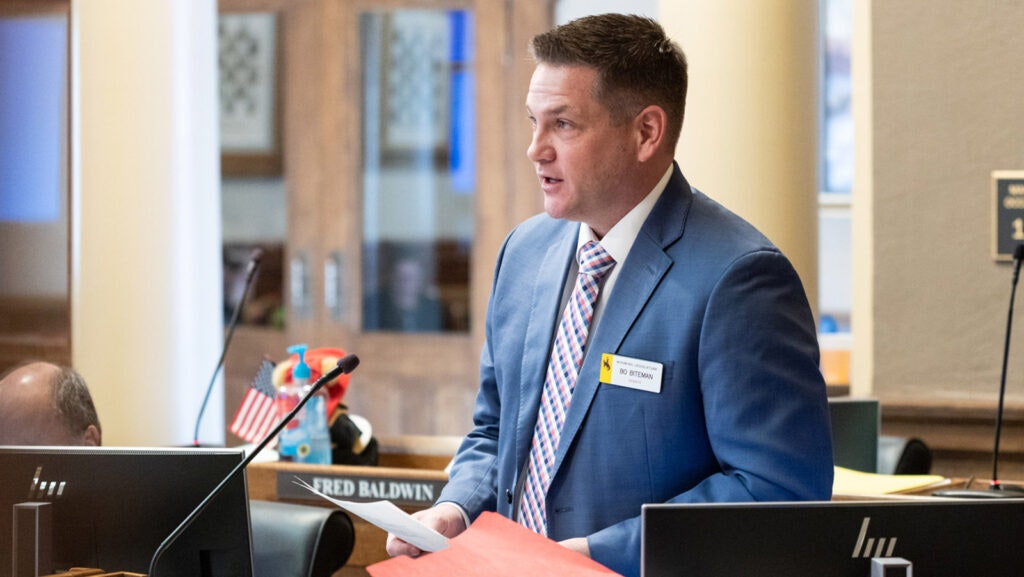An attempt to stop paying for cloud seeding efforts in Wyoming was rejected by the state Senate on Monday.
State Sen. Bo Biteman, R-Ranchester, proposed an amendment to an omnibus water bill that would have eliminated nearly all state funding for the program.
“The fact that we rely on other people’s funding to do something where the science is a little sketch, probably a good sign that it’s not there yet,” Biteman said of Wyoming’s $1.1 million investment in the practice.
Biteman said his amendment originated “from your newly minted cloud seeding skeptic caucus.”
Cloud seeding is seen by supporters as a potential benefit for Cowboy State farmers, kayakers and other water enthusiasts as a way to bolster statewide and local water reserves.
By augmenting mountain snowpacks, supporters hope the seeding will counteract the effects of climate change and help quench the thirst of drought-stricken areas throughout the state.
The amendment was defeated on a 18-13 vote.
Skepticism
During discussion on the amendment, Sen. Bob Ide, R-Casper, referenced a 2021 Scientific American story that said there is little definitive evidence on the effectiveness of cloud seeding and a 2015 study from the Bureau of Reclamation that says, “the proof the scientific community has been seeking for many decades is still not at hand.”
Sen. Larry Hicks, R-Baggs, questioned whether money should be dedicated to a program that has questionable results.
“The main question I come back to is, is it cost efficient?” he said.
A 2014 research study analyzing the results of Wyoming’s pilot program showed cloud seeding causing a 5% to 15% increase in the “efficiency” of mountain snow.
Newer calculations estimate an additional annual water flow from 12,000 to 49,000 acre-feet as a result of seeding. A 2017-20 study in Idaho shows that three of 18 cloud-seeding events there were successful, according to the National Center for Atmospheric Research and the University Corporation for Atmospheric Research.
Hicks believes seeding works, but usually under perfect conditions, which require preexisting moisture in the air. He suggested adding a sunset to the program to give it a deadline to show results.
All Hail
Sen. Tara Nethercott, R-Cheyenne, spoke on behalf of cloud seeding and mentioned its benefits for mitigating hail, mentioning how southern Wyoming is in a severe hail beltline.
“It doesn’t eliminate the hail, but it makes the hail size smaller from this technology,” Nethercott said. “It is a way to try to finesse the impact of storm damage from the size of the hail to smaller hail to eliminate crop damage, property damage that we’re all very familiar with in this part of the state.”
Sen. John Kolb, R-Rock Springs, mentioned how his southwestern region of the state will back any efforts to mitigate drought conditions.
The Colorado River Basin, which feeds the Flaming Gorge Reservoir south of Green River, has been devastated for 23 years by unprecedented drought.
A cost-sharing agreement in the Colorado River Basin was finalized in 2018 for ground-based efforts to combat shrinking water levels, which extends through fall 2026. Under the agreement, Wyoming pays 37% and the “other Colorado River Basin water users or other interested parties” are on the hook for the remaining 63%.
It’s not clear what would happen to this agreement if Wyoming ceased all funding for cloud seeding.
Costs
The proposed cloud seeding projects make up $1.1 million of the $23.2 million Omnibus Wate Construction bill.
“There’s good projects in that water bill and I’d hate to have to vote against a water bill because of some cloud seeding projects,” Biteman said.
The projected total cost of the Medicine Bow and Sierra Madre airborne seeding in next year’s budget is $875,000, up slightly from 2022. The Cheyenne Board of Public Utilities chips in $50,000 a year for this service.
Airborne cloud seeding has been conducted each year in the Medicine Bow and Sierra Madre ranges since 2018.
There also are 10 remote-controlled, ground-based generators located on the western and southern aspects of the Wind River Range. The total cost to run all of the generators is $805,000, but the state only expects to foot $301,000 of this bill next year.
In a separate bill during the 2022 session, the Legislature also approved a $300,000 cost-benefit analysis of the Medicine Bow-Sierra Madre seeding.
How It Works
Cloud seeding uses silver iodide to enhance ice crystal production within clouds.
When seeding is done from a plane, the pilot ignites one flare at a time, shooting the compound into the cloud. The iodide causes water droplets in the clouds to form ice crystals that become heavier and fall faster, which sometimes initiates snowfall.
Wyoming’s cloud seeding operations formally began in 2014 on the heels of the Wyoming Weather Modification Pilot Project program, which had run for nine years prior but relied solely on ground-based cloud seeding generators.
What started as a project focused in the Wind River Mountains has since expanded to other parts of Wyoming.
Airborne seeding, which involves shooting iodide out of flares strapped to the wings of an airplane, was added in 2018.





